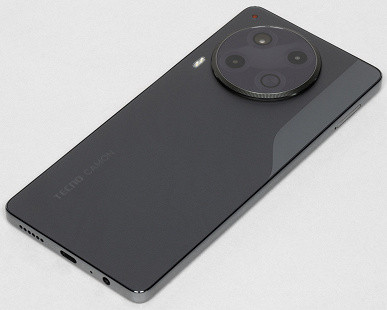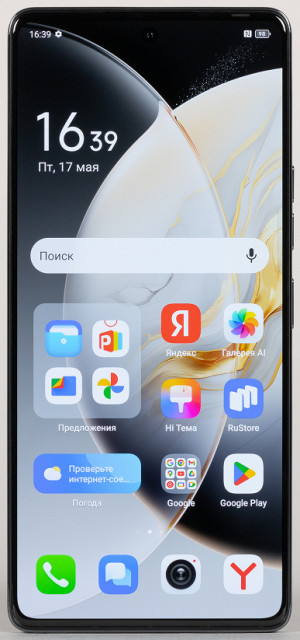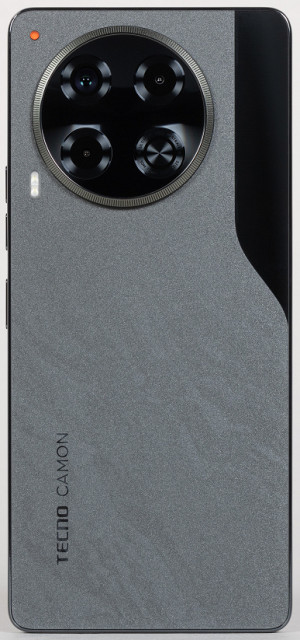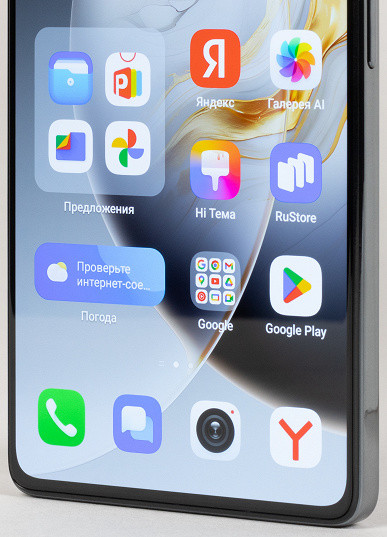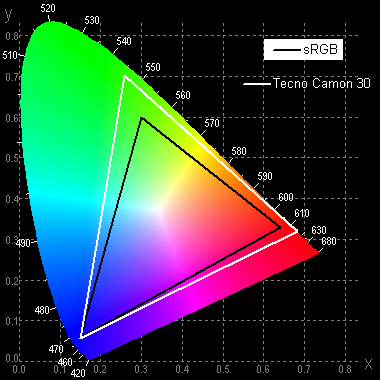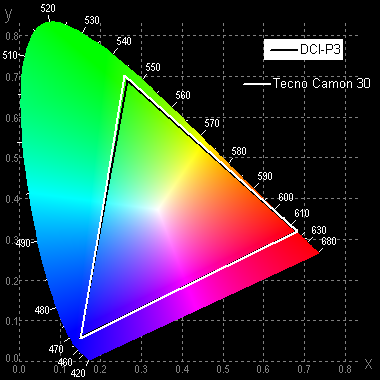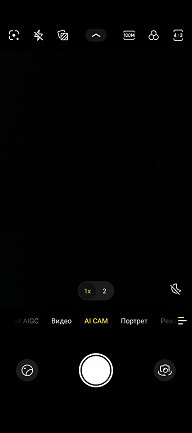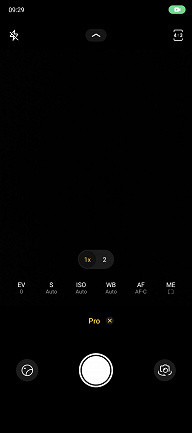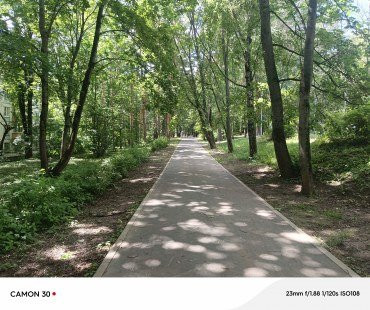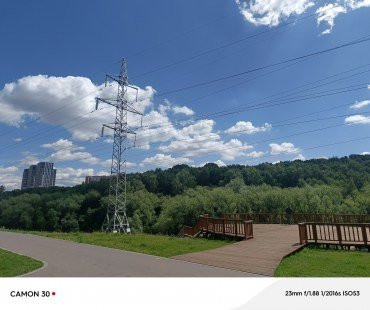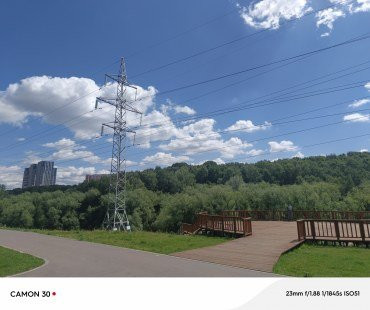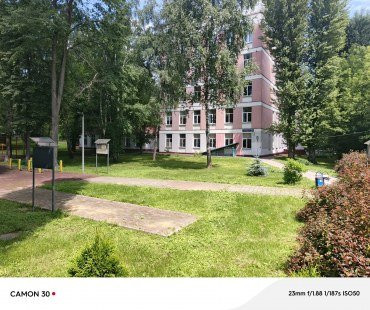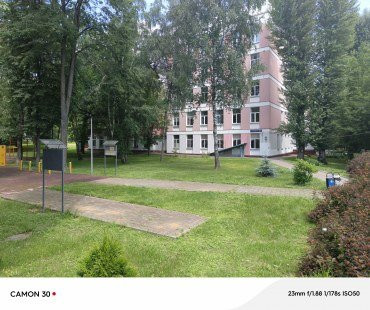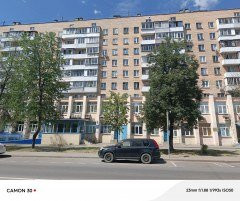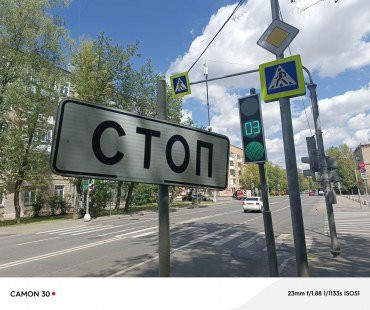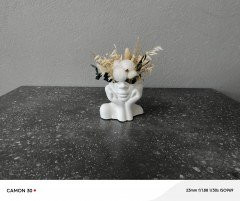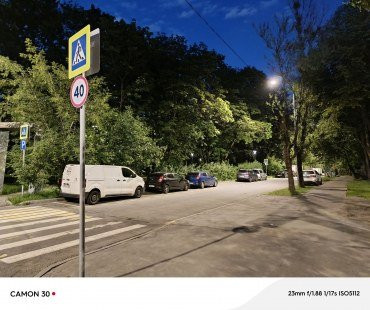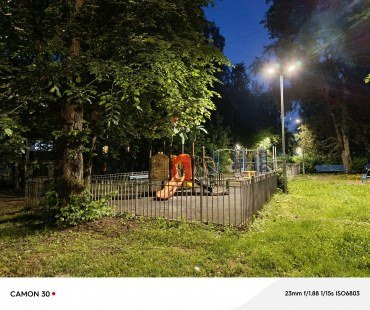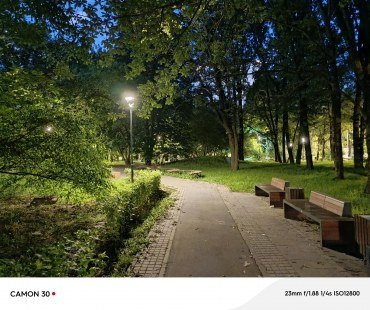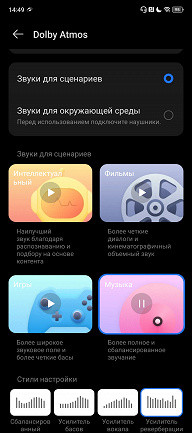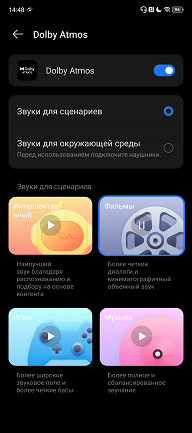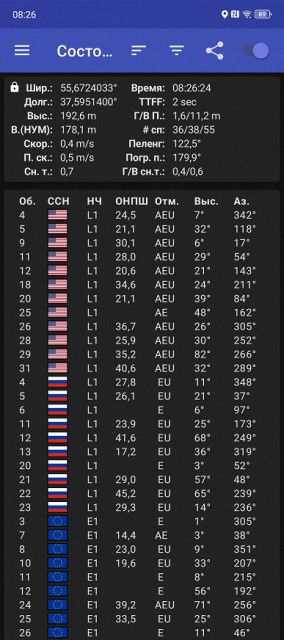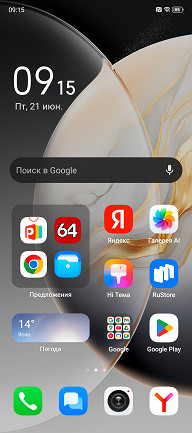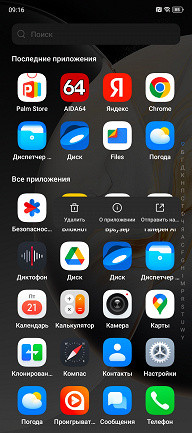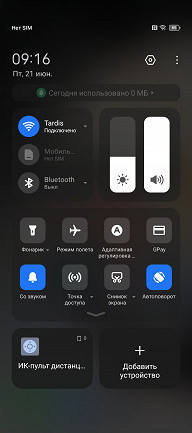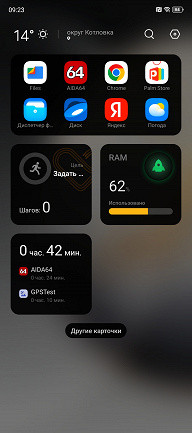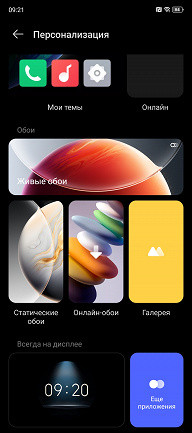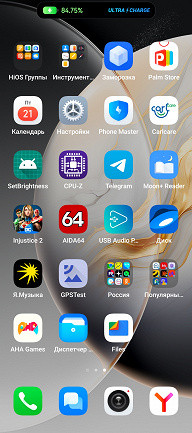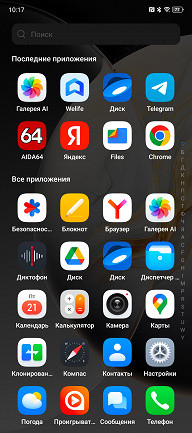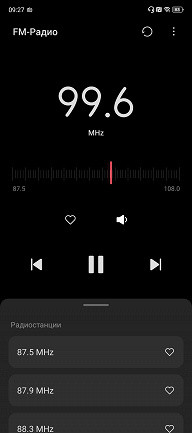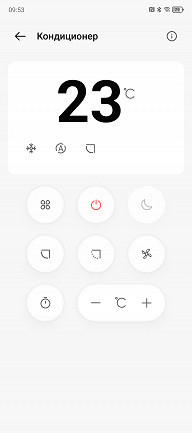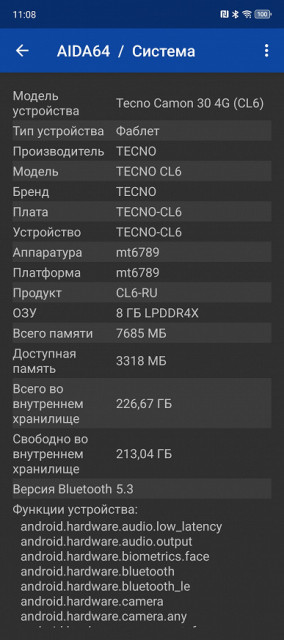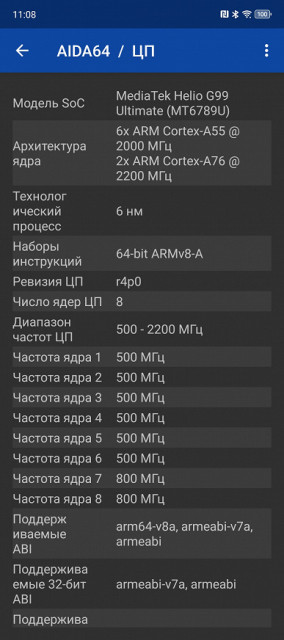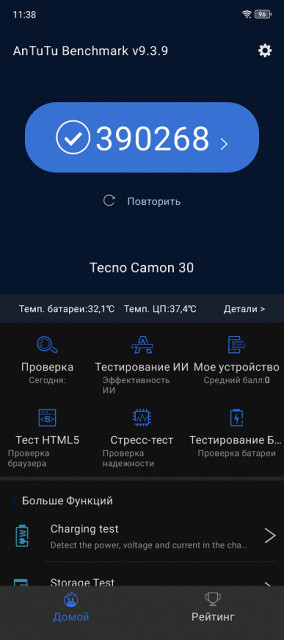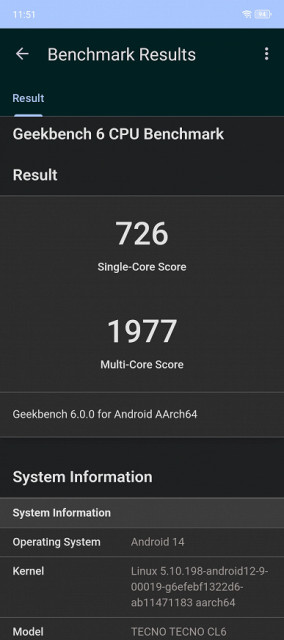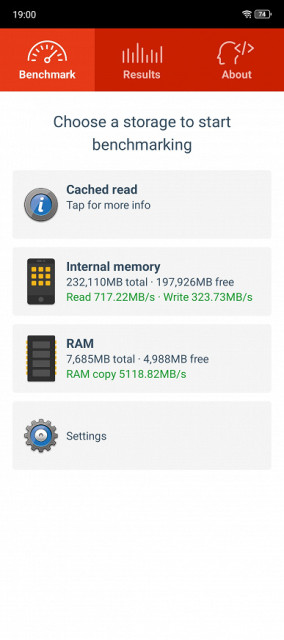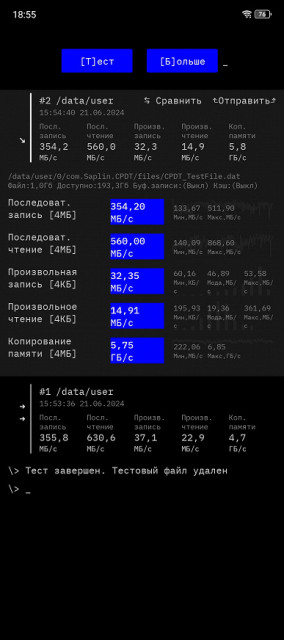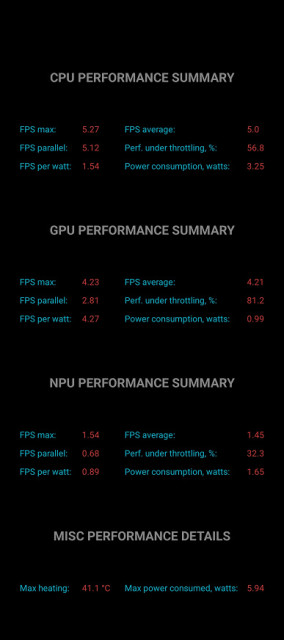We continue our acquaintance with the Camon 30 line of “camera phones” from Tecno. We have already tested the flagship model of this series — Camon 30 Premier 5G. Now it’s the turn of the junior and budget model, known as Tecno Camon 30. To avoid confusion, we note that there are two versions of this smartphone: with and without 5G support. Externally and in terms of basic characteristics, they are identical, however, the 5G version is equipped with a MediaTek Dimensity 7020 chipset with an integrated 5G modem, and the regular version is MediaTek Helio G99 Ultimate. It is the latter that we will talk about today.
Despite belonging to the “camera phones”, the budget of the device limits its capabilities in terms of cameras. There is one main camera with a resolution of 50 megapixels, a 1/1.57″ sensor and optical stabilization (OIS). There is also a front camera with a resolution of 50 megapixels and a fast autofocus function based on the user’s eyes.
In addition, Tecno Camon 30 is equipped with a headphone jack, an IR blaster, a separate microSD card slot and an FM receiver. These days, such features are becoming increasingly rare, especially in budget devices, giving users a pleasant nostalgia for the times when they were standard. The design of the entire Camon 30 line is inspired by vintage cameras, which gives the smartphones a special charm and appeal.
Declared technical characteristics
| SoC (processor) | MediaTek G99 Ultimate, 8 processor cores (2×Cortex-A76 @2.2 GHz + 6×Cortex-A55 @2.0 GHz), 6 nm process technology (TSMC) |
|---|---|
| Video chip | Mali-G57 MС2 (1100 MHz) |
| Memory | 8/12 GB RAM (LPDDR4X, 2133 MHz) and 256 GB ROM (UFS 2.2) |
| microSD support | dedicated connector |
| Display | AMOLED, 6.78″, 1080×2436, 120 Hz, 393 ppi, Always On Display |
| operating system | Android 14 (HiOS 14 shell) |
| Mobile networks | up to 4G LTE inclusive (GSM, WCDMA, HSPA+, TDD LTE, FDD LTE) |
| SIM cards | Nano-SIM (2 pcs.) |
| Wi-Fi | Wi-Fi 5, 802.11a/b/g/n/ac |
| Bluetooth | Bluetooth 5.3 |
| Other functions | FM radio, USB Host (OTG), NFC, IR port |
| Satellite navigation | GPS, GLONASS, BDS, Galileo |
| Cameras |
|
| Sensors |
|
| Speakers | Stereo with Dolby Atmos support |
| Headphone jack | mini jack 3.5 mm |
| Battery | 5000 mAh, 70 W charging |
| Water and dust protection | IP53 |
| Dimensions | 165×75×8 mm |
| Weight | 190 g |
Packaging and equipment
Tecno Camon 30 comes in a cardboard box with a removable lid, decorated in signature white and blue colors. The packaging contains brief technical specifications and also contains a gold sticker with the Hi-Res certification logo. The presence of this certification and a headphone jack is of particular interest, which we will talk about later.
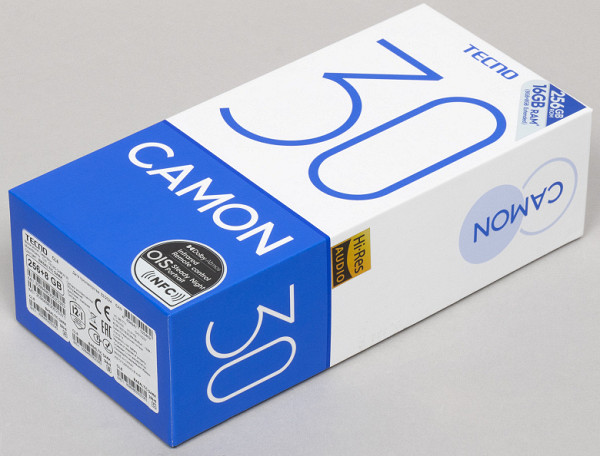
The package contents are quite generous: in the box, in addition to the smartphone itself, there is a 70 W power supply, a 1 meter long charging cable, a case, a “clip” for removing the SIM card tray, a protective glass and a kit for cleaning the screen before installing it.
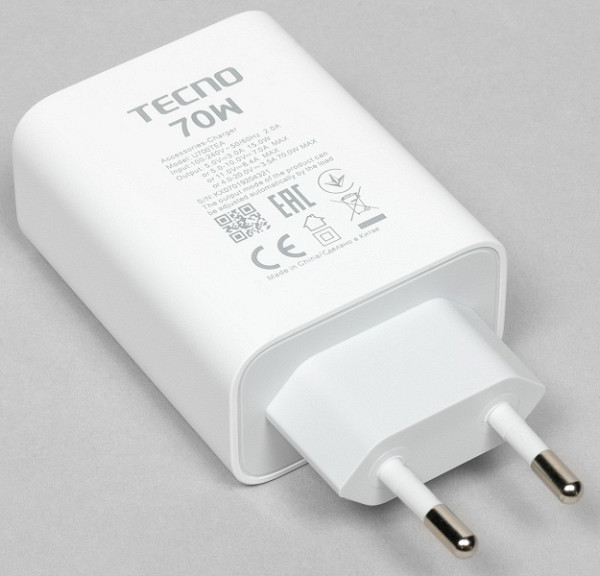
The case, to my surprise, turned out to be plastic, not silicone. It is transparent and does not hide the design of the phone, although when viewed from the side, a “rainbow effect” is noticeable. All ports are accessible, and the buttons are covered with protective pads, which makes pressing them a little more difficult in the case. The plastic is of acceptable quality, and the case is able to protect the device, but it quickly becomes covered with scratches. For the first time it is quite suitable, but over time you will want to replace it.
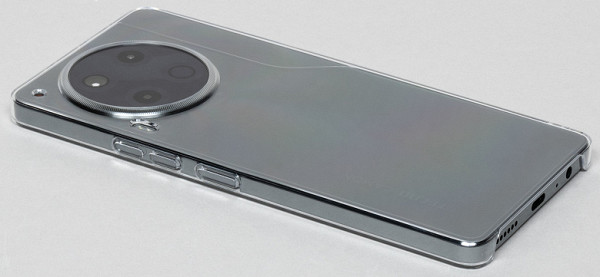
Design and ease of use
Tecno Camon 30 is available in three colors: Basalt Black, Pearl White and Desert Orange. The first two options have a glass back panel, while the latter is made of eco-suede. During testing, we had the black version, strict and laconic. The design of the entire Camon 30 line is inspired by vintage cameras, which really shows: the ribbed ring around the camera block is reminiscent of the zoom control on the lens, and a small imitation notch on the back panel looks like a recess for better grip of the camera. This gives the smartphone a stylish and unusual look, which is especially valuable in an era of monotonous design of modern devices.
The smartphone case is plastic, without metal inserts, like the flagship of the series. The device is relatively thin — only 8 mm without a case, and has a light weight — 190 g. There is protection against water and dust according to the IP53 standard, which means resistance to splashes of light rain, but it is better to protect the ports and openings from moisture. The back panel is matte and slightly textured, which provides a secure grip and minimizes the appearance of fingerprints. However, the prints are clearly visible on the decorative glossy “notch”.
The back panel has a “marble texture”, as the developers call it, which gives the device a unique look. The logo, located in the lower right corner, does not stand out too much and maintains the overall simplicity of the design.
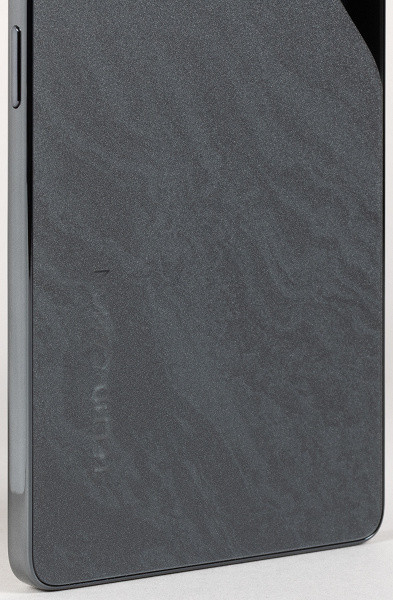
The edges of the screen protrude slightly from the body, creating a bulging feeling, but this is not the currently popular “waterfall” that many users criticize. The selfie camera is located in a circular notch at the center of the top of the screen.

The design of the camera block is the same for all smartphones in the line, which is logical and convenient. However, Tecno Camon 30, unlike the flagship of the series, has only one rear camera. Therefore, two holes in the block are occupied by light and depth sensors, and one is probably simply closed with a plug. There is also a very bright flash with two LEDs on the back panel.
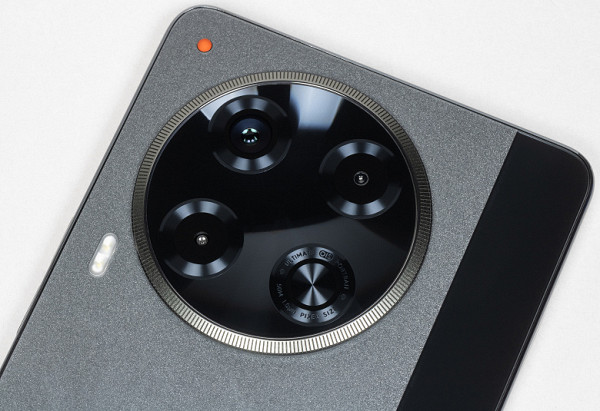
The rounded camera block protrudes noticeably above the surface, but its width is enough to ensure that the smartphone lying on the table does not sway too much when working with the screen.

In the upper right corner of the rear panel there is an LED indicator that can signal the start of charging, shooting, incoming calls or unread notifications. Its behavior can be configured through the system menu, which is useful for users who are accustomed to placing their smartphone with the display down — as practice shows, there are quite a lot of them. The fingerprint scanner is located below the screen, and its placement is quite low, almost at the bottom edge. This makes its use inconvenient, since reaching it with a finger of the same hand that holds the smartphone is not very convenient. You can get used to it, but it will take some effort.
At the bottom end there are holes for one of the speakers and a microphone for voice communication, a USB Type-C port, as well as a 3.5 mm minijack for headphones.

At the top end we see holes for a second speaker and an additional microphone, plus an IR port “peephole” for controlling household appliances.

The flagship model of the line has caused some comments due to the unusual and inconvenient location of the keys. In Tecno Camon 30, everything is in its place: the buttons are located on the right side of the case. First there are two volume buttons, and below them is the power button.

The keys are of normal size and protrude slightly above the surface of the case. They are pressed with medium force and a pleasant soft click.
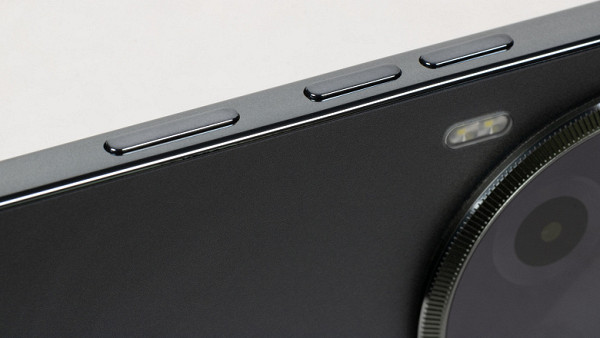
The card tray is located on the left side of the case. It is removed in the standard way — using the included “clip” or other thin object of sufficient length.

The tray can accommodate two Nano-SIM cards, plus a separate place is provided for a microSD memory card — in case the built-in 256 GB of ROM is not enough.

Screen
The front surface of the screen is made of a glass plate with a mirror-smooth surface that is scratch-resistant. The anti-glare properties of the screen are superior to those of the Google Nexus 7 (2013), judging by the reflection of objects. The screen is coated with an effective oleophobic (grease-repellent) layer, which makes it much easier to remove fingerprints and slows down their appearance compared to regular glass.
When manually adjusting the brightness, the maximum value is about 530 cd/m² under normal conditions, and with the “High Brightness Mode” option activated it can reach 980 cd/m² in bright sunlight. Overall, the maximum screen brightness is very high. The fewer white areas there are on the screen, the brighter it becomes, making maximum brightness even more impressive. Thanks to excellent anti-glare properties, screen readability in daylight remains at a good level, and the dark theme not only saves battery power, but also improves the visibility of information on the screen in bright light. The minimum brightness with manual settings is 2 cd/m², which allows you to comfortably use the device in complete darkness.
Automatic brightness adjustment works based on a light sensor located on the front panel to the right of the front speaker grille. In automatic mode, screen brightness is adjusted based on changes in ambient light. At standard settings, the auto-brightness function reduces brightness to 2 cd/m² in complete darkness, sets it to 130 cd/m² in office lighting conditions (approximately 550 lux) and increases to 980 cd/m² in direct sunlight. Despite this, if you try to manually increase the brightness in complete darkness, it may become higher, but after changing the ambient light, the values will return to their original values. As a result, the auto-brightness function works quite adequately, but does not allow you to fine-tune the brightness to individual preferences.
At high and medium brightness levels there is significant modulation at around 60, 90 or 120 Hz. The graphs below show brightness (vertical axis) versus time (horizontal axis) for several brightness settings. First introduced is the 60Hz refresh rate mode.
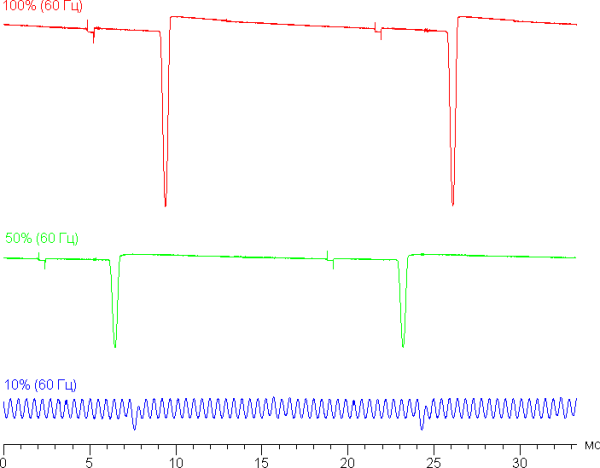
At high and medium brightness, the screen modulation frequency is low (60 Hz), and the modulation duty cycle is also low. In this case, the modulation phase varies across the screen, which eliminates visible flicker. With a significant decrease in brightness, the modulation switches to a high frequency (2.16 kHz), but there is still no visible flicker.
In the screen settings, you can activate modes with an increased refresh rate of up to 90 and 120 Hz.

In 90 and 120 Hz modes, scrolling smoothness increases noticeably. Let's see if this changes the nature of the modulation. 90Hz mode:
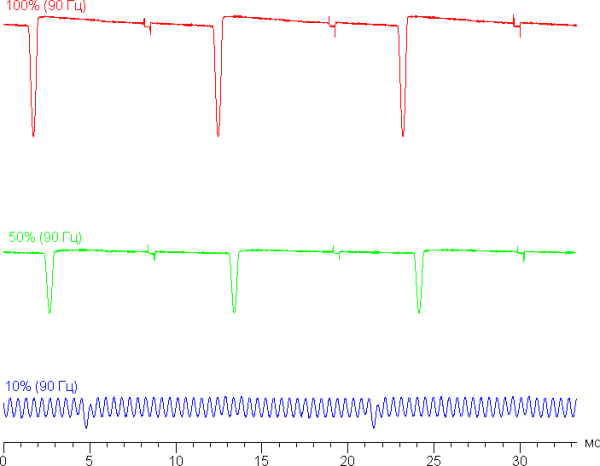
At high and medium brightness, the modulation frequency increases to 90 Hz, while at low brightness the modulation pattern remains the same as at the 60 Hz refresh rate. There is still no visible flicker.
120Hz refresh rate mode available:
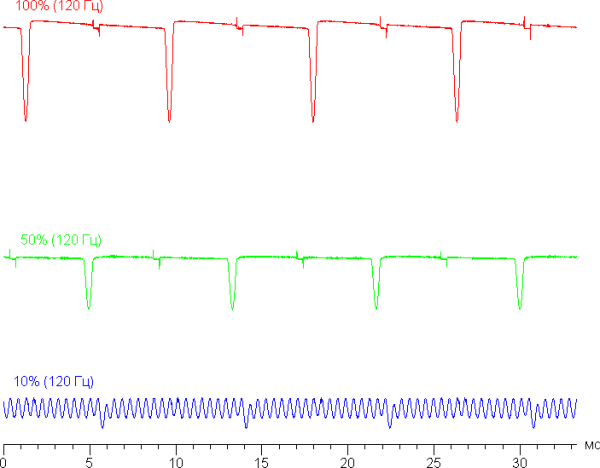
At high and medium brightness, the modulation frequency increases to 120 Hz, while at low brightness the modulation pattern remains the same as at the 60 Hz refresh rate. There is no visible flicker.
The screen uses an AMOLED matrix — an active matrix based on organic light-emitting diodes. A full-color image is formed using subpixels of three colors: red ®, green (G) and blue (B), and the number of red and blue subpixels is half that of green, which can be designated as RGBG. This is confirmed by a fragment of a microphotograph.
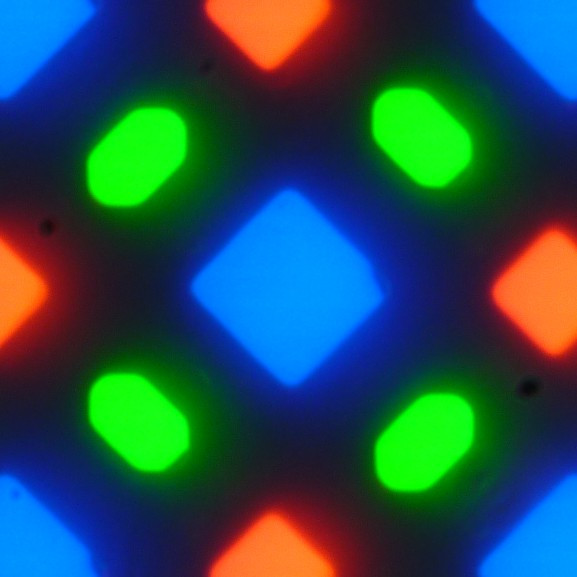
On a fragment of a microphotograph one can count 4 green subpixels, 2 red (of which 4 are halves) and 2 blue (1 whole and 4 quarters). By repeating these fragments, you can completely fill the screen without breaks or overlaps. Such matrices are referred to as PenTile RGBG, which is a term coined by Samsung. Screen resolution is determined by the green subpixels, which means that the resolution of the red and blue subpixels will be lower. Despite this, jagged edges and other artifacts have minimal impact on image quality due to the high resolution.
The screen demonstrates excellent viewing angles. White color takes on a slight blue-green tint when it deviates significantly, but black remains true black at any angle, making the contrast setting virtually unusable. For clarity, photographs are provided that compare the screens of a smartphone and another device (Nexus 7). Both screens display the same images with a brightness of about 200 cd/m², and the color balance on the camera is set to 6500 K. The photographs show a white field perpendicular to the screens.

Note the good uniformity of brightness and color tone of the white field.
And test picture (Original color profile):

Colors appear oversaturated on the smartphone screen (note the tomatoes, bananas, napkin and face shade) and the color balance is noticeably off. The photograph serves only as a conditional illustration, as it does not always reliably reflect the quality of color rendering. For example, there is no pronounced reddish tint of white and gray in photographs of a smartphone screen when viewed directly, which is confirmed by tests using a spectrophotometer. This is due to the fact that the spectral sensitivity of the camera matrix may not exactly match the characteristics of human vision.
The photo was taken after selecting the «Original Color» profile in the screen settings. There are two profiles available.

When choosing the first, Vivid Colors, the colors are even more oversaturated and unnatural:

This effect is achieved by slightly expanding the color gamut and increasing color contrast. It is also possible to adjust the shade between “Cool Color” and “Warm Color”.
The brightness at an angle for both screens decreases noticeably, but for the smartphone the drop in brightness is much less pronounced. This makes the screen visually brighter at formally the same brightness level, especially since the screen of a mobile device is often viewed at an angle.
Switching the state of the matrix elements occurs almost instantly, but at the turn-on edge a step with a width of approximately 17 ms (which corresponds to a screen refresh rate of about 60 Hz), 11 ms (90 Hz) or 8 ms (120 Hz) can be observed. For example, this is illustrated by the dependence of brightness on time during the transition from black to white.
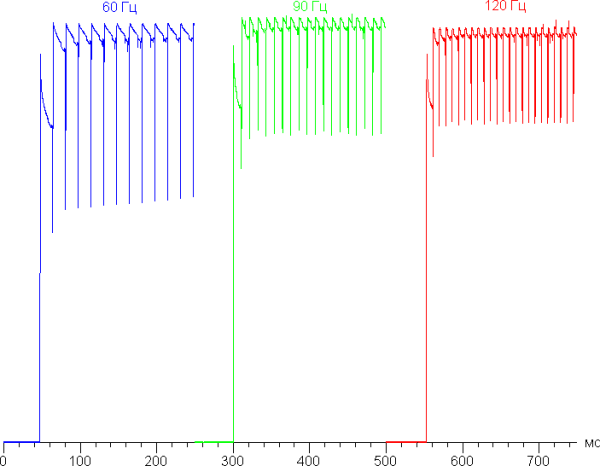
In some conditions, such a step can lead to plumes trailing behind moving objects.
Analysis of the gamma curve, constructed using 32 points with equal intervals in shades of gray, showed no blockages in shadows or highlights. The exponent of the approximating power function is 2.34, which is slightly higher than the standard value of 2.2. This means that the image is slightly darkened, but the actual gamma curve is almost identical to the power law.
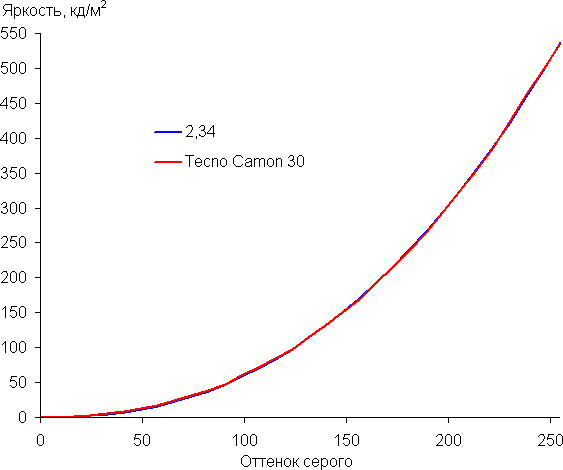
For OLED screens, the brightness of parts of the image changes dynamically depending on the nature of the content being displayed, which may result in a slight decrease in brightness for predominantly bright images. Therefore, the resulting dependence of brightness on hue (gamma curve) may not accurately reflect the gamma of a static image, since the measurements were carried out with sequential output of shades of gray almost over the entire screen.
The color gamut, even when using the «Original Color» profile, significantly exceeds sRGB and is close to the DCI-P3 space.
In the case of the Vivid colors profile, the color gamut is slightly wider than DCI-P3:
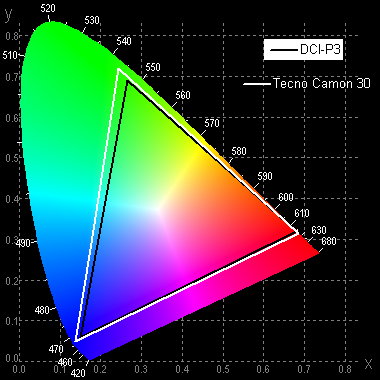
In this case, the component spectra (that is, the spectra of pure red, green and blue) are very well separated:

In the case of the Original color profile there is already a slight cross-mixing:

The grayscale balance, after some minor adjustments (see image above), is quite acceptable: color temperature is close to the standard 6500 K, and the deviation from the blackbody spectrum (ΔE) is less than 10 units, which is a good indicator for a consumer device. Color temperature and ΔE remain relatively stable from shade to shade, which has a positive effect on the visual assessment of color balance. The darkest areas of the gray scale can be ignored, since the color balance there is less critical, and the measurement error at low brightness is large.
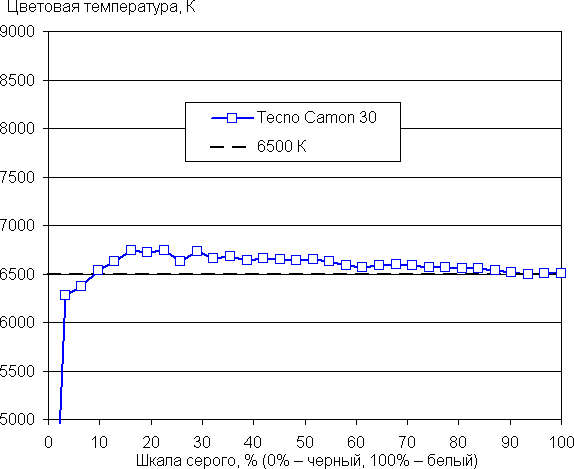
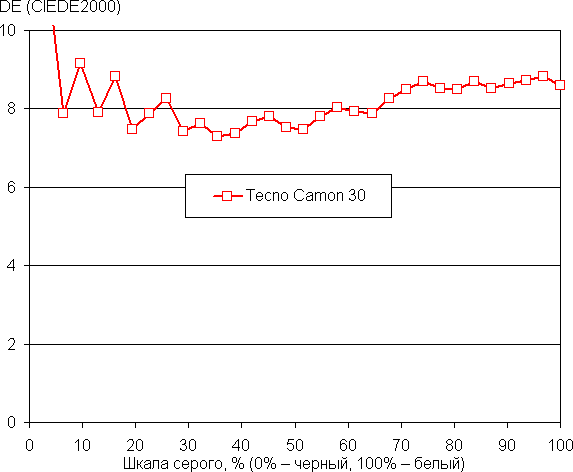
Of course, the “Eye Protection Mode” setting is available, which allows you to reduce the intensity of the blue component of the screen. Although bright light can disrupt the daily (circadian) rhythm, the problem can be solved by simply lowering the brightness to a comfortable level. There is no point in distorting the color balance by reducing the contribution of blue when you can simply adjust the brightness.

Obviously, this device does not support DisplayPort Alt Mode for USB Type-C, which means there is no ability to output image and sound to an external device via the USB port.
In general, the screen has a very high maximum brightness (up to 980 cd/m² at peak and 530 cd/m² under normal conditions) and excellent anti-glare properties, which allows you to comfortably use it outdoors even on a sunny day. In complete darkness, the brightness can be reduced to a comfortable level (up to 2 cd/m²). The automatic brightness adjustment mode works quite adequately, although it does not allow fine-tuning to individual preferences.
Screen benefits include no visible flicker, an effective oleophobic coating, and support for refresh rates up to 90 and 120 Hz. OLED technology provides true blacks (when the screen is not reflective), good white field uniformity, and less brightness drop when viewed from an angle compared to LCD screens. However, wide color gamuts can lead to distorted and unnatural colors when viewing videos and photos. However, the screen quality is generally high.
Cameras
The budget smartphone Tecno Camon 30 in the line of “camera phones” is equipped with one main camera:
- 50 MP, 1/1.57″ sensor, 1.0 µm pixels, f/1.88 mm aperture
- PDAF (phase detection autofocus), OIS (optical image stabilization)
The shooting quality is supported by a depth sensor and a light sensor. Although there is a 2x digital zoom mode, it is simply a digital zoom. Software simulation of lenses with different focal lengths is also available in portrait mode. Users are offered various processing and creative shooting options, which we will also briefly mention. There is a Pro mode with a set of standard options.
By default, the camera operates in pixel binning mode, creating images with a resolution of 12 megapixels. However, when you press the “magic button”, you can get photos with a resolution of 100 megapixels, although nowhere is it explained how this is achieved with a 50 megapixel matrix. However, there is a noticeable gain in detail, especially considering that in the 12-megapixel mode details are compromised by noise reduction and sharpening. At the same time, the file size increases significantly (from 4 to 30 MB), and when viewed at full size, the pictures look loose, with faded and indistinct colors.
In general, there are no questions about the quality of pictures in the default mode. Of course, this is not the level of “photo flagships,” but no one expected this from a relatively budget device. Due to post-processing (so-called “computational photography”), pictures in the default mode look impressive, although not always natural — colors are often oversaturated, and sharpening is too noticeable. However, there are no problems with «bleached» skies, low contrast and other nuances that can reduce the visually perceived quality of the image. This is more than enough to send pictures to friends, save them as memories or publish them on social networks. And for mobile photography enthusiasts, there are more “advanced” smartphones from completely different price segments.
Other examples of pictures taken with the main camera:
Tecno Camon 30 does not have a dedicated macro mode, but this does not prevent you from photographing your favorite flowers, leaves or insects. Autofocus works at relatively short distances, and although the resulting images are not impressive in terms of detail, they look quite nice. In such cases, it’s worth trying the 100 MP mode — the detail may be higher, but don’t expect a significant increase. If you don't plan to do any post-processing yourself and pull out all the possible details, it makes more sense to use the default mode.
As for digital zoom, it’s not for nothing that the manufacturer has allocated only two modes in the camera interface: 1× and 2×. When zoomed in twice, the image (obviously obtained by cropping a full-size photograph with some processing) is still suitable for publication on social networks, where it is unlikely to be enlarged and carefully examined. However, at higher magnification the quality deteriorates significantly and there is no point in discussing it.
In portrait mode, noise is smoothed out more aggressively, plus various beautifying filters are available. Whether to use them or not is a matter of taste. The camera interface allows you to change the focal length of the lens, but in reality it is again a digital zoom. Accordingly, the closer the approximation, the more noise appears in the image.

The selfie camera (50 MP) in “smart camera” mode quickly focuses, provides acceptable detail and relatively natural colors. In portrait mode, software background blur is available, which is packaged as an aperture setting. If you set it to «f16», the blur will be barely noticeable, and the problems traditional for this mode will hardly arise. However, at the “f1.0” value, sharp transitions from the body to the background, “eaten” hairs and other characteristic problems of automatic “clipping” become visible. Luckily, you can always switch to the default camera mode and just take a good photo without any additional settings.
Another interesting feature of the front camera is the presence of its own flashlight with the ability to adjust the brightness and temperature of the glow. Brightness and temperature are indeed adjustable, but getting high-quality photos in this lighting is almost impossible, and autofocus works worse than in normal light. However, as an artistic medium this option can be useful.
The darkest thing Moscow could offer at the time of testing was the so-called “navigational twilight.” However, this was enough to automatically activate the “night mode,” which the manufacturer places special emphasis on, promising “ultra-clear night photography that has become even brighter and more impressive.” Indeed, photos taken with the Tecno Camon 30 look better than several other models in the same price segment. However, there is still a long way to go to a truly good level of shooting: the images are often overexposed, and only by indirect signs can one understand that they were taken in the dark. The colors are clearly oversaturated, and in the process of dealing with noise, detail often suffers.
Well, as a nice bonus, the camera app offers several “smart functions” that are more like fun “play and forget” toys, but can help generate some content for social networks for those who care about it. For example, in the AR Space application, you can draw something over the camera image, after which the drawn thing will be “attached” to its position, which allows you to shoot an interesting video against the background. The quality of the resulting video leaves much to be desired, but it looks funny — it’s quite suitable for creating a pair of vertical “reels”.
It is also possible to “replace” your face in the video with some kind of avatar that will try to copy your facial expression, as well as generating “portraits” using neural networks. The quality of generation is acceptable, although this is unlikely to surprise anyone now. Except for how strange the images can end up being. That is why such features are already found in budget smartphone models.
But let's return directly to the camera. It can shoot video at a maximum resolution of up to 2.5K at 30 frames per second, but stabilization in this mode is weak — hand shake when shooting and steps are practically not compensated for, and a noticeable “strobe” effect is added to the image. The colors are oversaturated, the picture is slightly brightened, but overall it looks good — for small “memory” videos this is enough. Shooting in Full HD resolution at 60 frames per second looks better — stabilization works more clearly, but there are unpleasant sharp jerks that spoil the impression.
In the 1920×1080@30 fps mode, the “maximum stabilization” option is available, in which part of the image is cropped. Here the stabilization is really effective, but more and more questions arise about the picture quality: detail drops noticeably, and the “strobe effect” reaches its peak. Which of these evils to choose in each specific case is up to the user to decide.
Audio
The presence of the Hi-Res certification logo and headphone jack on the packaging of the Tecno Camon 30 caught our attention towards its audio system. While the manufacturer hasn't announced a dedicated DAC, and our test utilities didn't detect one, that leaves uncertainty as to which headphones the smartphone will be able to power. The Tecno Camon 30 handles Soundmagic E80 headphones with an impedance of 64 Ohms easily, providing a good power reserve. However, the full-size Sennheiser HD 560S with an impedance of 120 Ohms does not open up completely, and for comfortable listening you have to turn the volume up almost to maximum.
To test the audio system, we used the USB Audio Player Pro, which can send a signal directly, bypassing the built-in “enhancers”. Dolby Atmos has been previously disabled. The frequency response was measured using an E1DA Cosmos ADC. The frequency response graph turned out to be almost perfectly linear; small deviations in the deep bass and high frequency areas are noticeable only when the scale is increased.
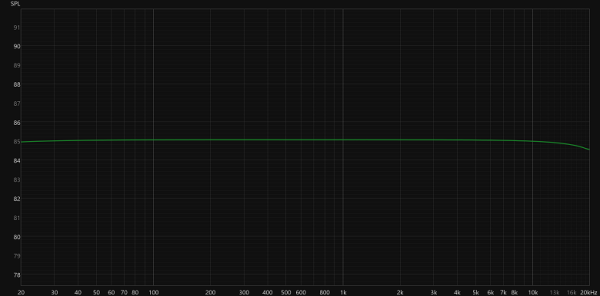
The level of harmonic distortion (THD) at 1000 Hz is 0.0097%, which is an excellent result for a smartphone. The noise level is also at an acceptable level. Although the Tecno Camon 30 does not claim to be an audiophile device and should not be considered a specialized music smartphone, it is quite capable of providing decent sound quality when using wired headphones.
Dolby Atmos support really improves the sound, making it more spacious. A special application provides profiles for various types of content and listening conditions, as well as several equalizer presets. There is also an “intelligent mode” that automatically adjusts the sound to the current conditions. Although the final result is often impressive, sometimes you want to turn off the “enhancer”. Either way, it's worth trying different settings for the best sound.
The smartphone is equipped with two built-in speakers, which provide a basic stereo effect, although not very pronounced due to their close location. Overall, the sound is nicer than devices with a single speaker. The volume is enough for comfortable viewing of videos and listening to music in small rooms, if there are no other sound sources. Audio processing is not disabled when playing through speakers, so frequency response graphs are not particularly meaningful. The sound starts at around 200 Hz, and the frequency balance varies depending on the selected profile.
Telephone and communications
The Tecno Camon 30 smartphone supports mobile networks up to 4G and demonstrates a reliable connection in the Moscow region: the connection is not lost, and recovery after a break occurs quickly. It is equipped with a Wi-Fi 5 wireless adapter (802.11a/b/g/n/ac), supports Bluetooth 5.3 and NFC.
The satellite navigation module works with GPS, Glonass, BDS and Galileo. Satellites are detected quickly during a cold start, and positioning accuracy is high.
The volume of the speaker is sufficient for comfortable communication, the voices of the interlocutors are clear and intelligible. The vibration motor works well: the vibration response when interacting with the interface and the vibration alert are noticeable and not annoying. All necessary sensors, including a gyroscope, are present.
Software and multimedia
Tecno Camon 30 runs on Android 14 with a custom HiOS 14 shell. It offers a user-friendly interface and neat design, high-quality translation into Russian and the absence of pop-up advertising. Built-in applications are presented in a reasonable number, and local services such as weather and keyboard are provided by software from Yandex. Google Play and Google services are also available.
The appearance of the shell is in many ways similar to MIUI from Xiaomi, but it has its own features that require getting used to. For example, to move an application icon to the desktop, you need to use a special button that appears when you hold the icon in the menu, rather than dragging it. The shell supports gesture control and conveniently implements the creation of floating windows.
The Always-On Display function is available, but in a limited mode — the screen is activated only when you touch or change the position of the smartphone, and not constantly. A trendy Dynamic Port is also available, similar to the Dynamic Island, which displays information such as charging status around the camera. Swiping right from the main desktop opens the “widget area.”
Among the pre-installed applications, it is worth noting Carlcare, which helps you apply for service. There are also functions for transferring data from a previous phone, “freezing” and “cloning” applications, as well as the ability to use multiple accounts in software that does not support this by default.
The smartphone is equipped with a built-in FM receiver, for which the connected headphones are used as an antenna. In the absence of headphones, reception is possible, but the quality leaves much to be desired. In the receiver control application, you can automatically search for stations, manually adjust the frequency and record broadcasts. However, there is no function to display radio station names.
The IR remote control is conveniently controlled using the pre-installed Welife application. The database of manufacturers and devices is extensive, which has allowed us to successfully manage various household appliances — from TVs to air conditioners.
Performance
The Tecno Camon 30 smartphone is powered by MediaTek Helio G99 Ultimate 6nm processor with 8 cores and Mali-G57 MP2 GPU. Although the chip is not the newest and was introduced a couple of years ago, the Ultimate version provides sufficient performance for modern games at medium graphics settings, such as PUBG, with a comfortable gaming experience, although you should not expect high FPS levels. The device interface is smooth and responsive.
The amount of RAM is 8 or 12 GB depending on the version, with the possibility of increasing due to ROM by 8 or 12 GB, respectively. The built-in storage is 256 GB, expandable via microSD card. Support for external devices is also available via the USB Type-C port in USB OTG mode.
Testing in comprehensive tests AnTuTu and GeekBench:
The smartphone is tested on the latest versions of popular benchmarks, and the results are then summarized in tables. For clarity, the data is compared with the results of other devices from different price segments. Since comparison is only possible between results obtained in the same versions of the test programs, some worthy and relevant models evaluated in earlier versions of the software remain outside the scope of this analysis.
| Tecno Camon 30 (MediaTek Helio G99 Ultimate) | OnePlus Nord N30 SE (Mediatek Dimensity 6020) | Realme 12 Pro+ (Qualcomm Snapdragon 7s Gen2) | Google Pixel 8 Pro (Google Tensor G3) | Huawei Pura 70 Ultra (Kirin 9010) | |
|---|---|---|---|---|---|
| AnTuTu (v9.x) (bigger is better) | 390268 | 308773 | 576685 | 808457 | 969362 |
| GeekBench 6 (bigger is better) | 726/1977 | 523/1762 | 894/2801 | 1741/4349 | 1446/4492 |
Testing the graphics subsystem in GFXBenchmark gaming tests:
| Tecno Camon 30 (MediaTek Helio G99 Ultimate) | OnePlus Nord N30 SE (Mediatek Dimensity 6020) | Realme 12 Pro+ (Qualcomm Snapdragon 7s Gen 2) | Google Pixel 8 Pro (Google Tensor G3) | Huawei Pura 70 Ultra (Kirin 9010) | |
|---|---|---|---|---|---|
| GFXBenchmark Aztec Ruins OpenGL (1080p Offscreen, fps) | 18 | 16 | 35 | 107 | 82 |
| GFXBenchmark Aztec Ruins Vulkan (1080p Offscreen, fps) | 16 | 13 | 39 | 108 | 82 |
| GFXBenchmark Car Chase ES 3.1 (1080p Offscreen, fps) | 17 | 14 | thirty | 78 | 56 |
| GFXBenchmark Manhattan ES 3.1 (1080p Offscreen, fps) | 28 | 24 | 54 | 142 | 60 |
| GFXBenchmark T-Rex (1080p Offscreen, fps) | 68 | 63 | 122 | 328 | 337 |
Testing in browser cross-platform tests:
| Tecno Camon 30 (MediaTek Helio G99 Ultimate) | OnePlus Nord N30 SE (Mediatek Dimensity 6020) | Realme 12 Pro+ (Qualcomm Snapdragon 7s Gen 2) | Google Pixel 8 Pro (Google Tensor G3) | Huawei Pura 70 Ultra (Kirin 9010) | |
|---|---|---|---|---|---|
| Google Octane 2 (bigger is better) | 25539 | 19244 | 30529 | 52617 | 5180 |
| JetStream (bigger is better) | 79 | 64 | 85 | 102 | 20 |
Memory speed test results:
Heat
We test for performance degradation when heating using the Burnout Benchmark program, which allows you to load the CPU, GPU and NPU:
| Stress on | Heating performance, as a percentage of maximum |
|---|---|
| CPU | 57% |
| GPU | 81% |
| NPU | 32% |
Battery life
The battery of the Tecno Camon 30 smartphone has a capacity of 5000 mAh, which is the standard for many modern devices in various price categories. The battery life results were at the average level for budget smartphones.
Testing was carried out at normal power consumption levels, without enabling power saving features, although they are present in the device. Test conditions included: setting the minimum comfortable brightness level (about 100 cd/m²). The tests included: endless reading in Moon+ Reader (with the standard light theme), continuous video playback in HD (720p) over a home Wi-Fi network, and the game Injustice 2 with automatic graphics settings.
| Battery capacity | Reading mode | Video mode | 3D gaming mode | |
|---|---|---|---|---|
| Tecno Camon 30 | 5000 mAh | 21:00 | 17:00 | 7:00 a.m. |
| OnePlus Nord N30 SE | 5000 mAh | 23:00 | 16:00 | 8:00 a.m. |
| Honor X7b | 6000 mAh | 27:00 | 23:00 | 8 h 30 min |
| Poco X5 Pro 5G | 5000 mAh | 18:00 | 20:00 | 7:00 a.m. |
| Realme 10 Pro+ 5G | 5000 mAh | 19:00 | 18:00 | 5 h 00 m |
| Samsung Galaxy S24 Ultra | 5000 mAh | 32 h 00 m | 26 h 00 m | 9:00 a.m. |
| Google Pixel 8 Pro | 5050 mAh | 22:00 | 18:00 | 7:00 a.m. |
| Honor 90 | 5000 mAh | 21:00 | 18:00 | 7:00 a.m. |
| Honor Magic V2 | 5000 mAh | 21:00 | 17:00 | 6:00 a.m. |
Using the bundled 70W charger in “ultra-fast” mode, the Tecno Camon 30 charges in about 43 minutes. Wireless charging is not supported.
Bottom line
At the time of testing, Tecno Camon 30 cost about $230 — this is no longer the most budget segment, but still very affordable. The level of expectations from a device in this price category is initially low, but the smartphone demonstrates confident results in almost all aspects: the screen is of good quality, although colors may be distorted when viewing photos and videos, the shell is comfortable, and the performance allows you to comfortably use the device in everyday use and play less demanding games.
The quality of photos and videos is far from flagship level, but for publishing on social networks it is quite acceptable, which cannot always be said about smartphones with a similar price. In this regard, Tecno Camon 30 justifies its place in the line of “camera phones”. The design is original and pleasant, while maintaining laconicism, which may appeal not only to a youth audience.
Despite the average level of the device, the manufacturer has added a number of interesting features that can attract attention: a front flash with adjustable light temperature, a built-in sound enhancer and an LED indicator on the rear panel. Additionally, the smartphone offers nostalgic features that were popular in the past: a headphone jack, an IR blaster, a dedicated microSD card slot, and an FM receiver. All these features work correctly, making the Tecno Camon 30 a truly interesting device at a relatively low price.

